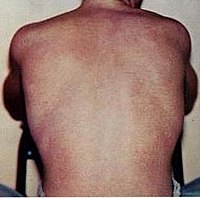
Photo from wikipedia
Background Early diagnosis and treatment of malaria symptoms reduces the risk of severe complication and malaria transmission. However, delay in malaria diagnosis and treatment is a major public health problem… Click to show full abstract
Background Early diagnosis and treatment of malaria symptoms reduces the risk of severe complication and malaria transmission. However, delay in malaria diagnosis and treatment is a major public health problem in India. The primary aim of the study was to determine cut-off for the delay in seeking treatment of fever, and the secondary aim was to identify the factors associated with delay in malaria-endemic areas of Assam, Northeast India. Methods The present study analysed data from two prior cross-sectional surveys (community- and hospital-based) that was conducted to study the health-seeking behaviour of people residing in high malaria-endemic areas of Assam, Northeast India. The hospital-based survey data were used to determine optimal cut-off for the delay in reporting, and further, used to identify the factors associated with delay using community-based data. Results Mean age of fever cases was similar in both community- and hospital-based surveys (23.1 years vs 24.2 years, p = 0.229). Delay in reporting fever was significantly higher among hospital inpatients compared to community-based fever cases (3.6 ± 2.1 vs 4.0 ± 2.6 days; p = 0.006). Delay of > 2 days showed higher predictive ability (sensitivity: 96.4%, and ROC area: 67.5%) compared to other cut-off values (> 3, > 4, and > 5 days). Multivariable logistic regression analysis revealed that the adjusted odds ratio (aOR) of delay was significantly higher for people living in rural areas (1.52, 95%CI: 1.11–2.09), distance (> 5 km) to health facility (1.93, 95%CI: 1.44–2.61), engaged in agriculture work (2.58, 95%CI: 1.97–3.37), and interaction effect of adult male aged 20–40 years (1.71, 95%CI: 1.06–2.75). Conclusion The delay (> 2 days) in seeking treatment was likely to be twice among those who live in rural areas and travel > 5 km to assess health care facility. The findings of the study are useful in designing effective intervention programmes for early treatment of febrile illness to control malaria.
Journal Title: BMC Public Health
Year Published: 2020
Link to full text (if available)
Share on Social Media: Sign Up to like & get
recommendations!